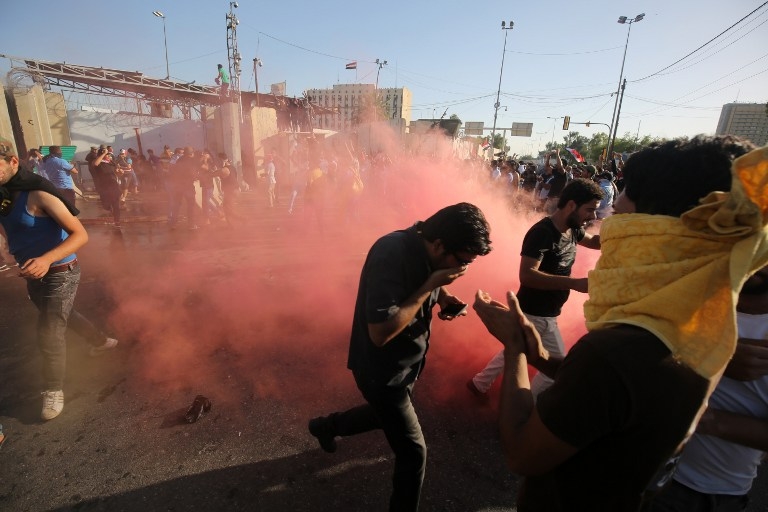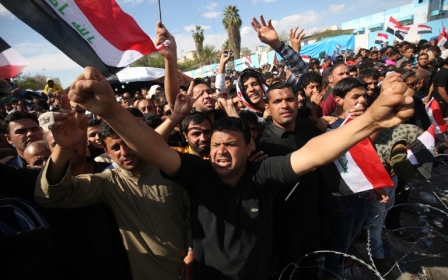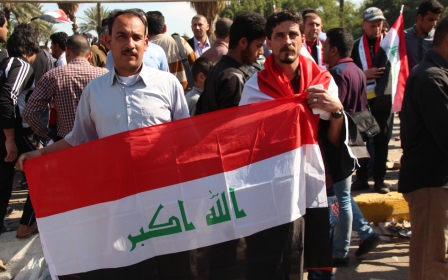Iraqi forces kill 2 protesters in Baghdad as Green Zone stormed

Iraqi forces killed at least two people on Friday night while trying to disperse protesters who stormed Baghdad's Green Zone and reportedly entered the office of Prime Minister Haider al-Abadi, officials said on Saturday.
Security and medical officials also said at least 57 people were wounded in Friday's unrest, in which forces used tear gas, water cannons and sound bombs against protesters, some of whom threw rocks and other debris.
Security forces also fired live rounds during the demonstration, mostly into the air, but officials said two protesters died of bullet wounds.
Thousands protesters loyal to influential Shia cleric Moqtada al-Sadr began to assemble after Friday prayers and attempted to enter the heavily fortified zone, three weeks after they invaded the Iraqi parliament over a long-running feud about corruption and the future of the Iraqi state.
Despite police resistance, some demonstrators were able to push into the zone and an AFP photographer at the scene reported Sadr supporters stormed the prime minister's office, with unverified reports on Twitter seemingly confirming the report.
The protesters eventually pulled out and security forces pinned the crowd back near one of the main bridges in central Baghdad as reinforcements arrived. Iraqi authorities imposed a curfew in Baghdad on Friday night.
"Curfew on Baghdad until further notice," read a statement released by the Joint Operations Command and also relayed on state television. Several reports suggested that one person may have been killed, but authorities and medical sources have so far not confirmed any casualties.
Middle East Eye's contributor in Baghdad Suadad al-Salhy said fears had been high that the protesters would try to occupy government buildings, which might spark further violence.
Toby Dodge, director of the London School of Economics' Middle East Centre, told MEE that the prospect of Shia-on-Shia violence was "pretty likely" given the polarisation developing between Sadr and his supporters and the main political blocs that have proven unwilling to give up power.
"This is an argument that is exclusive to the Shia community – it is between Sadr’s radicalism, widespread popular demands for far-reaching reform and better government [on the one hand], and the status quo Shia parties in the Green Zone," he said.
"What is so worrying is that all sides are highly armed. Sadr has a militia and the Supreme Council also has a militia, so this is potentially an explosive situation."
The spat dates back to last summer when anti-corruption protests broke out over the poor security situation and widespread power cuts. According to Dodge, the popular movement against government cronyism was quickly co-opted by Sadr and his supporters, who seized on the widespread demands for reform.
In March, they began a sit-in outside the Green Zone in a bid to pressure authorities into replacing political ministers with technocrats. Abadi has proposed reforms and wants to replace the current government of party-affiliated ministers, who are widely blamed for rampant corruption, with a cabinet of experts, but this has met with stiff opposition.
After weeks of threats, in late April thousands of supporters eventually stampeded into the Green Zone - which also houses the prime minister's office as well as the US and other embassies - and ransacked the parliament.
Sadr then called on his supporters to disperse, although he vowed they would return if change was not enacted - something which has thus far failed to happen, with parliament not meeting since the incident.
The cleric's role in this most recent Green Zone incursion is a subject of much debate. In a statement on Friday night, Sadr warned against attempts to block peaceful protests by his supporters.
"No side has the right to prevent that. Otherwise, the revolution will take another form," he said.
But while Sadr was heavily involved with the previous protests, personally staging a sit-in near the Green Zone, he had not returned to Baghdad in time for Friday's demonstrations and had not directly called for people to take to the streets, instead more generally calling for revolution earlier in the week.
According to Salhy, the protests may well have taken on a life of their own. Dodge, however, said that Sadr remains in control and is using the protests to push ahead with his agenda after weeks of stalemate.
“If the numbers are that large [in the thousands], then it’s not a rogue element and I don’t think this is being done to discredit him," he said.
"The parliament hasn’t met; there is political stalemate. I would have thought that this is his attempt to keep pressure on the ruling elite and keep the fire on the political process, but also within constraints that don’t make it a huge issue. It’s his way of saying I’m still here and we have not given up."
Public pressure is also heating up in the wake of deadly attacks on Shia communities claimed by the Islamic State (IS) group. In the last week, more than 200 people were killed in and around Baghdad, with hundreds more slain earlier this year.
Sadr City, a Baghdad suburb named for its support of the controversial cleric, has born the brunt of these recent attacks and fury over government failure to prevent the bloodshed is running high.
"This [public anger] is precisely what IS was aiming to do and pushing for," Salhy said. "Their attacks are their way to shake allegiances to the government and the state and to make people question the legitimacy of the government."
New MEE newsletter: Jerusalem Dispatch
Sign up to get the latest insights and analysis on Israel-Palestine, alongside Turkey Unpacked and other MEE newsletters
Middle East Eye delivers independent and unrivalled coverage and analysis of the Middle East, North Africa and beyond. To learn more about republishing this content and the associated fees, please fill out this form. More about MEE can be found here.




